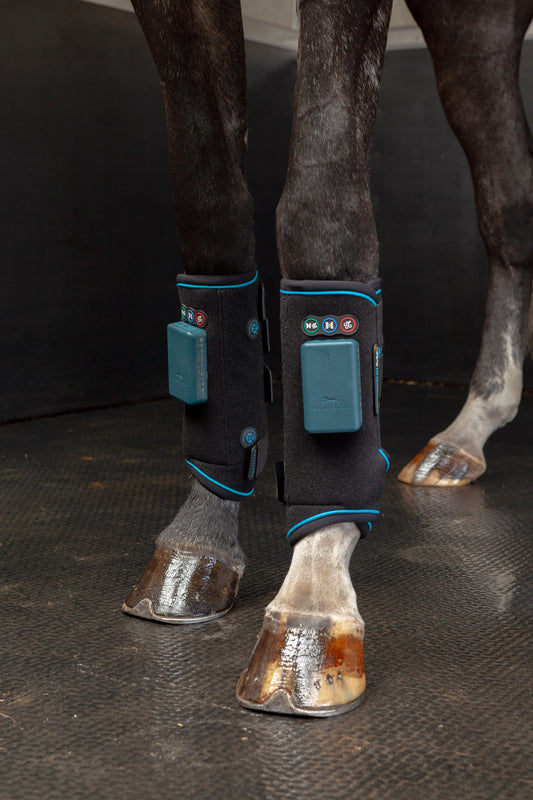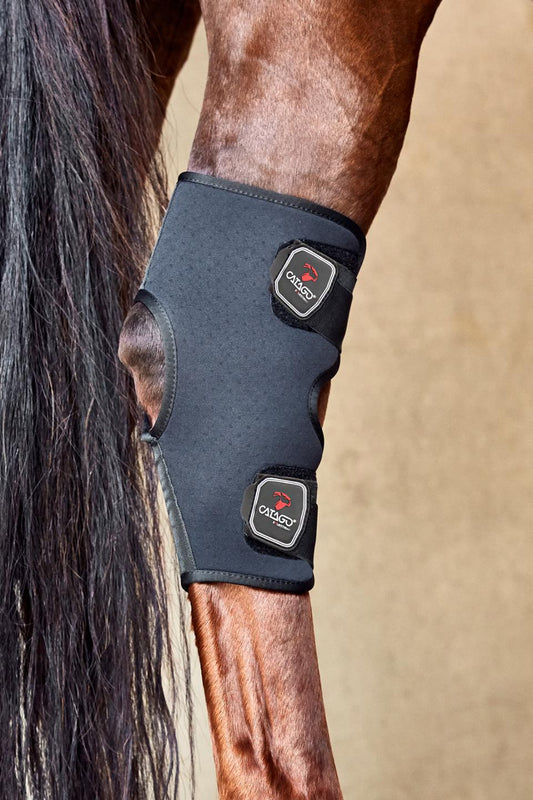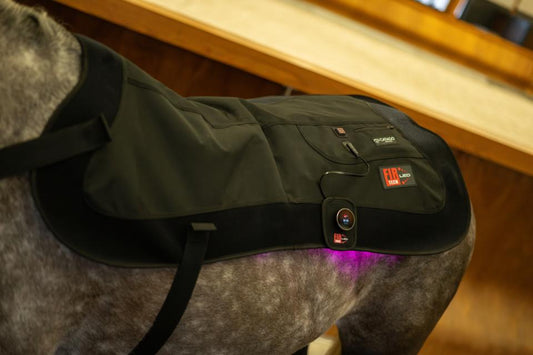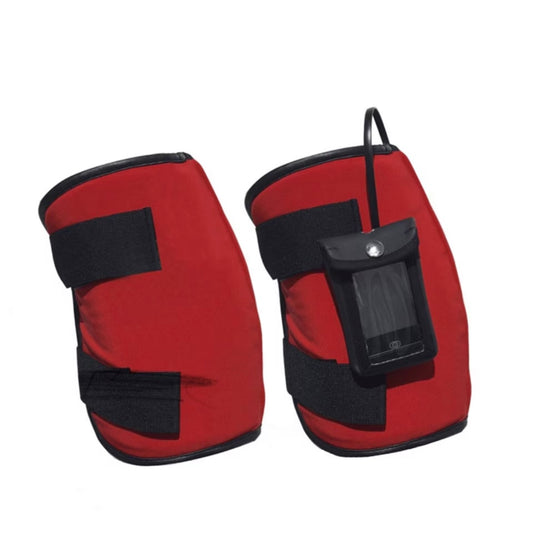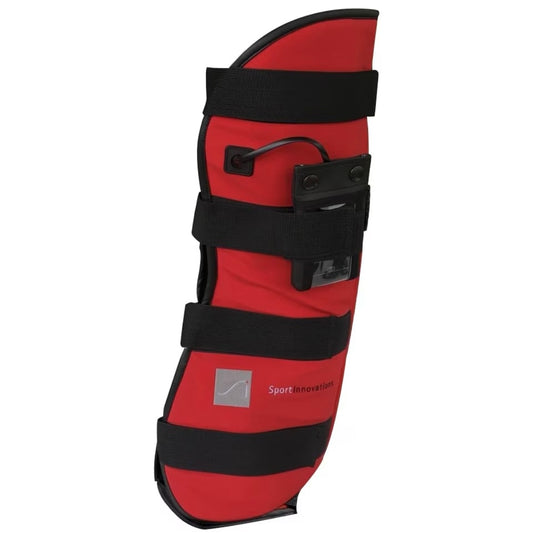Joint Injuries
Arthritis (Osteoarthritis)
Osteoarthritis (OA) is a degenerative joint disease characterized by the breakdown of cartilage and changes in the surrounding bone and soft tissues. This condition is common in older horses but can also affect younger ones due to injury, overuse, or genetic factors. OA causes pain, stiffness, and reduced joint mobility, affecting a horse’s performance and quality of life.
General Information
- What is Osteoarthritis?
Osteoarthritis is a progressive condition where the cartilage in a joint deteriorates, leading to bone-on-bone friction, inflammation, and pain. It commonly affects the hock, fetlock, and stifle joints in horses, though it can occur in any synovial joint. OA is chronic and worsens over time, though the rate of progression can vary. - Types of OA in Horses:
How to Recognize Arthritis (Osteoarthritis) in Horses
Early recognition of osteoarthritis is crucial for managing the condition and preventing further damage.
Common Signs of OA in Horses:
- Lameness: Mild to severe lameness, which may improve with rest.
- Stiffness: Particularly after rest or in the morning, when the horse first begins to move.
- Decreased Performance: Reluctance to perform tasks that require joint mobility, such as jumping or cantering.
- Swelling or Heat: Inflammation in the affected joint, often visible during acute flare-ups.
- Joint Pain: Sensitivity when palpating or flexing the joint, and discomfort when weight is placed on the limb.
- Muscle Wasting: Chronic arthritis can cause muscle atrophy around the affected joint due to disuse or altered movement.
Diagnosis:
A combination of clinical examination, radiographs (X-rays), and sometimes ultrasound or MRI are used to assess cartilage degradation, bone involvement, and soft tissue changes.
Causes of Osteoarthritis (OA) in Horses
Osteoarthritis can develop from various causes, ranging from aging to trauma or genetic predisposition.
Common Causes:
- Age: Natural wear and tear of cartilage with aging, common in older horses.
- Trauma or Injury: Previous joint injuries, such as fractures or ligament damage, increase the risk of developing OA.
- Conformation Issues: Abnormal limb alignment (e.g., straight-legged horses) can place extra stress on joints.
- Overuse or Overloading: Intense training or high-performance activities can lead to excessive wear on joints, especially without adequate rest.
- Joint Infection: Infections in the joint can accelerate cartilage damage, leading to OA.
- Genetic Predisposition: Some horses may inherit conditions that make them more prone to OA.
- Obesity: Excess weight puts added stress on joints, increasing the risk of OA.
- Poor Hoof Care: Improper trimming or shoeing can lead to abnormal gait, resulting in uneven joint stress.
How to Prevent Osteoarthritis (OA) in Horses
While osteoarthritis may be inevitable with age, there are several steps to minimize the risk or delay its onset.
Prevention Tips:
- Maintain a Healthy Weight: Prevent obesity by providing a balanced diet and regular exercise.
- Proper Conformation and Hoof Care: Ensure regular hoof trimming and corrective shoeing to maintain proper limb alignment.
- Consistent, Moderate Exercise: Avoid overtraining, especially during a horse's younger years, and gradually increase workload.
- Early Injury Treatment: Promptly treat joint injuries to avoid long-term damage that could lead to OA.
- Joint Supplements: Consider supplements containing glucosamine, chondroitin, and MSM to support cartilage health.
- Rest and Recovery: Allow horses to recover fully between training sessions to prevent overuse injuries.
What to Do if Your Horse Has Osteoarthritis (OA)
If you suspect osteoarthritis in your horse, it’s important to take immediate action.
Steps to Follow:
- Veterinary Evaluation: Have a veterinarian assess the condition through clinical exams and diagnostic imaging.
- Rest and Rehabilitation: Box rest may be necessary to allow inflammation to subside. Gradual, controlled exercise can help maintain muscle tone.
- Weight Management: Adjust diet and exercise to reduce weight and alleviate joint stress.
- Pain Management: Anti-inflammatory medications (NSAIDs) can help manage pain and inflammation.
- Cold Therapy: Apply ice or cold packs to reduce swelling during flare-ups.
- Physical Therapy: Gentle exercise like walking can help maintain joint function, but be cautious not to overload the joint.
- Joint Injections: In some cases, hyaluronic acid or corticosteroid injections may be recommended to reduce inflammation and promote healing.
- Modify Activity: Reduce or avoid activities that place excessive stress on the affected joint, such as jumping or sharp turns.
Therapies to Aid in the Recovery of OA
Various therapies can support healing and manage OA-related pain.
- PEMF Therapy (Pulsed Electromagnetic Field):
Helps reduce inflammation, stimulates healing, and improves circulation in the affected joint. - Infrared Therapy:
Increases blood flow, accelerates healing, and reduces pain and stiffness by promoting cellular regeneration. - LED Therapy:
Improves circulation and reduces inflammation, facilitating cartilage regeneration. - Vibration Therapy:
Enhances joint mobility, alleviates pain, and reduces stiffness in arthritic joints. - Cooling Therapy:
Cold therapy is beneficial during flare-ups to reduce swelling and inflammation. - NMES Therapy (Neuromuscular Electrical Stimulation):
Helps maintain muscle mass around the affected joint and improves joint support during recovery.
Conclusion
Osteoarthritis (OA) is a chronic and common condition in horses that can significantly impact their comfort and performance. Early detection, preventive measures, and proper management are key to minimizing its effects. A combination of rest, weight management, and therapies like PEMF, infrared therapy, and joint injections can significantly improve joint function and reduce pain. Work closely with your veterinarian to develop a tailored treatment plan to ensure the best outcomes for your horse.
Joint Sprains
A joint sprain in horses refers to an injury to the ligaments surrounding a joint, often caused by excessive force, stretching, or trauma that results in the ligaments being overstretched or torn. Joint sprains are common in performance horses or those involved in rigorous physical activities, such as jumping, racing, or working. Depending on the severity, joint sprains can lead to inflammation, pain, instability, and decreased performance.
General Information
A joint sprain occurs when a ligament, which connects bones within a joint, is injured. Ligaments are responsible for stabilizing joints, and when they are stretched or torn, the joint's stability is compromised. Joint sprains are classified into three grades based on the severity of the injury:
- Grade 1 (Mild): The ligament is stretched but not torn, causing mild pain and minimal swelling. The joint remains stable.
- Grade 2 (Moderate): There is partial tearing of the ligament with moderate pain, swelling, and limited mobility. The joint may exhibit some instability.
- Grade 3 (Severe): The ligament is completely torn, resulting in significant pain, swelling, instability, and a marked loss of joint function.
Joint sprains can occur in any joint but are most commonly seen in the fetlock, hock, and stifle joints of horses.
How to Recognize a Joint Sprain in Horses
Identifying a joint sprain early is crucial for effective treatment and recovery. Common signs include:
- Lameness: The horse may display a noticeable lameness, ranging from mild to severe, depending on the grade of the sprain.
- Swelling: Swelling around the affected joint due to inflammation in the ligaments and surrounding tissues.
- Pain on Palpation: The horse may show signs of discomfort when the affected joint is gently palpated. Flexion of the joint might also elicit pain.
- Heat in the Joint: Inflammation can cause the joint to feel warm to the touch, indicating increased blood flow and swelling.
- Reduced Mobility: The horse may be reluctant to move the affected limb, or there may be a noticeable decrease in the range of motion of the affected joint.
- Behavioral Changes: Horses with joint sprains may exhibit behavioral changes, such as irritability or reluctance to perform physical activities.
What Are the Causes of Joint Sprains in Horses?
Joint sprains can occur due to various causes, often involving trauma or excessive strain. Common causes include:
- Excessive Force or Trauma: Sudden, excessive force or impact (e.g., stumbling, slipping, or colliding with an object) can lead to ligament overstretching or tearing.
- Repetitive Stress: Repetitive movements, such as those involved in high-performance activities like racing, jumping, or dressage, can increase the risk of sprains over time.
- Poor Conformation: Horses with poor conformation may experience uneven stress on their joints, which can predispose them to ligament injuries.
- Improper Training or Overexertion: Rapid increases in training intensity, inadequate recovery time, or training on hard or uneven surfaces can contribute to joint sprains.
- Inadequate Hoof Care: Improper trimming or unbalanced hooves can cause abnormal movement patterns that put excessive stress on joints.
- Previous Injuries: Horses with a history of joint injuries are more likely to experience sprains again due to weakened or scarred ligaments.
- Age: Older horses or those with degenerative joint diseases may have weaker ligaments and are more susceptible to sprains.
How to Prevent Joint Sprains in Horses
While it may not be possible to prevent every joint sprain, several strategies can minimize the risk:
- Proper Training and Conditioning: Gradually increase training intensity and allow the horse’s body to adapt. Ensure adequate rest and recovery periods.
- Warm-up and Cool-down: Always incorporate proper warm-up and cool-down routines to prevent muscle and ligament strain.
- Foot Care: Maintain regular hoof care with appropriate trimming and shoeing to ensure proper limb alignment and reduce strain on joints.
- Adequate Surface: Train and work the horse on safe, even surfaces to avoid excessive stress or trauma to joints.
- Maintain a Healthy Weight: Prevent obesity, as excess weight places more strain on joints and ligaments.
- Strengthen Muscles Around Joints: Targeted exercises can help build muscle strength around joints to reduce the risk of ligament injuries.
- Early Intervention: Address any signs of lameness or discomfort promptly to prevent further joint problems.
What to Do if Your Horse Has a Joint Sprain
If your horse has a joint sprain, follow these steps to manage the condition and aid in recovery:
- Veterinary Examination: Consult a veterinarian for a thorough examination. Diagnostic imaging, such as X-rays or ultrasound, may be recommended.
- Rest: Provide box rest to allow the injured ligaments to heal. The duration of rest depends on the severity of the sprain.
- Cold Therapy: Apply cold therapy (e.g., ice packs or cold hosing) to reduce inflammation and swelling, especially within the first 48 hours after injury.
- Pain Management: Use NSAIDs (e.g., fenylbutazon/flunixin meglumine) to manage pain and inflammation as directed by your veterinarian.
- Supportive Bandaging: In some cases, a supportive bandage may be recommended to stabilize the joint and reduce swelling.
- Limit Movement: While on box rest, limit movement to allow proper healing. Gradually introduce controlled exercise once acute pain subsides.
- Rehabilitation: Once the initial healing phase is complete, implement gentle rehabilitation exercises to restore mobility and strength, with guidance from a veterinarian or equine physiotherapist.
Therapies to Help Treat Joint Sprains
Several therapeutic options can support healing and recovery:
- PEMF Therapy (Pulsed Electromagnetic Field): Reduces inflammation, promotes blood flow, and accelerates ligament healing, especially in the early stages.
- Infrared Therapy: Increases circulation to the affected area, reduces stiffness, and accelerates tissue healing.
- LED Therapy: Stimulates cell regeneration, reduces inflammation, and speeds up ligament and tissue healing.
- Vibration Therapy: Improves circulation and muscle strength around the injured joint, supporting faster recovery.
- Cooling Therapy: Reduces swelling and inflammation, alleviating pain and preventing further injury during the acute phase.
- NMES Therapy (Neuromuscular Electrical Stimulation): Helps maintain muscle tone around the affected joint, preventing atrophy and promoting joint stability.
Conclusion
Joint sprains are a common injury in horses that can be caused by trauma, overuse, or poor conformation. Early diagnosis, appropriate rest, and pain management are crucial for successful recovery. Therapeutic interventions such as PEMF, infrared therapy, and cold therapy can help reduce inflammation, manage pain, and accelerate the healing process. Work closely with your veterinarian to develop a customized treatment plan for optimal recovery and return to activity.
Joint Capsule Injury
A joint capsule injury occurs when the protective, fibrous capsule surrounding a joint is damaged. The joint capsule is crucial for providing structural support and protecting the synovial membrane, which produces the fluid needed for joint lubrication. Joint capsule injuries can lead to joint instability, inflammation, and pain, significantly affecting the horse’s movement and performance.
General Information
The joint capsule is a tough, fibrous structure that surrounds most synovial joints, providing both mechanical protection and stabilization. It contains the synovial fluid that lubricates the joint and nourishes the cartilage. A joint capsule injury typically results from trauma or strain and can range from mild stretching of the capsule to complete tears.
Injuries to the joint capsule often involve the following:
- Inflammation: Pain, swelling, and decreased joint function caused by inflammation within the joint capsule.
- Joint Effusion: Accumulation of fluid in the joint, often a result of trauma or injury to the capsule.
- Instability: Damage to the joint capsule may lead to instability, complicating healing and recovery.
Common joints affected by capsule injuries include the fetlock, hock, and stifle joints, particularly in performance horses engaged in high-impact activities.
How to Recognize a Joint Capsule Injury
Recognizing a joint capsule injury involves observing both clinical signs and understanding the injury history. Key signs include:
- Lameness: Mild to moderate lameness, often worsening with movement or pressure on the affected joint.
- Swelling and Heat: Common signs of injury include swelling around the joint and warmth due to inflammation.
- Pain on Palpation: Gentle palpation of the joint may elicit pain, especially in the joint capsule area.
- Restricted Range of Motion: The horse may resist movement in the affected limb, and the joint may feel stiff or painful when flexed or extended.
- Joint Effusion: Fluid accumulation in the joint, leading to noticeable swelling, is often seen in more severe injuries.
In severe cases, joint instability may occur, and the horse may exhibit more significant signs of pain, such as reluctance to move or bear weight on the affected limb.
Causes of Joint Capsule Injury
Several factors contribute to joint capsule injuries in horses:
- Trauma or Impact: Direct trauma (e.g., fall, collision, or sudden impact) is a primary cause, common in horses involved in high-impact sports like jumping, racing, or eventing.
- Excessive Stress: Repetitive stress, overuse, or sudden changes in training intensity can weaken the joint capsule, increasing the risk of injury.
- Twisting or Hyperextension: Abrupt twisting or hyperextension of a joint during athletic movements can overstretch or tear the joint capsule.
- Poor Conformation or Foot Problems: Horses with poor conformation or improperly balanced feet are more susceptible to joint stress and injury.
- Previous Injury: Horses with a history of joint injuries are at increased risk of joint capsule damage due to weakened or scarred tissues.
- Infection or Inflammation: Infections within the joint can compromise the joint capsule, leading to injury.
How to Prevent Joint Capsule Injury
Preventing joint capsule injuries focuses on overall health, proper conditioning, and care:
- Gradual Conditioning: Increase the intensity and duration of training gradually to allow the horse’s body to adapt. Avoid abrupt increases in workload.
- Proper Warm-up and Cool-down: Ensure proper warm-up before exercise and cool-down afterward to prepare joints for activity and promote recovery.
- Strengthening Muscles Around Joints: Build muscle strength around key joints to provide better support and reduce the risk of injury.
- Foot Care: Ensure regular hoof care and proper trimming to maintain balanced movement patterns and reduce abnormal joint stress.
- Monitor for Signs of Fatigue or Pain: Check for signs of fatigue, overexertion, or pain during and after training, and intervene early to prevent further injury.
- Appropriate Training Surface: Use safe, even surfaces for training to minimize the risk of joint trauma.
- Rest and Recovery: Provide adequate rest periods between intense training sessions to allow joints to recover and repair.
What to Do if Your Horse Has a Joint Capsule Injury
If you suspect a joint capsule injury, the following steps can help manage the condition:
- Veterinary Consultation: Always seek veterinary care for a proper diagnosis. Your veterinarian may recommend diagnostic imaging (X-rays or ultrasound) to assess the injury.
- Rest: Box rest is essential to prevent further strain and allow the joint capsule to heal. The duration depends on the injury severity.
- Cold Therapy: Apply cold therapy (ice packs or cold hosing) within the first 48 hours to reduce swelling and inflammation.
- Pain Management: Use NSAIDs (e.g., bute or banamine) as directed by your veterinarian to control pain and inflammation.
- Supportive Care: Depending on the injury severity, supportive bandages or braces may be recommended to stabilize the joint and reduce strain.
- Limited Movement: Restrict movement during the initial healing phase. Gradually introduce controlled, low-impact exercise once the joint begins to heal.
- Physical Therapy: Incorporate rehabilitation exercises or controlled walking to restore range of motion and strengthen muscles around the joint once the acute phase passes.
Therapies to Help Treat Joint Capsule Injuries
Several advanced therapies can aid in healing and promote faster recovery:
- PEMF Therapy (Pulsed Electromagnetic Field)
- Infrared Therapy
- LED Therapy
- Vibration Therapy
- Cold Therapy
- NMES Therapy (Neuromuscular Electrical Stimulation)
These therapies help reduce inflammation, promote healing, and improve recovery time.
Conclusion
Joint capsule injuries in horses are often caused by trauma, overuse, or abnormal joint stress. Early recognition, appropriate veterinary care, rest, and therapeutic interventions are essential for full recovery. Therapies such as PEMF, infrared, and LED therapy can reduce inflammation and accelerate the healing process. Implementing preventive strategies, including proper training, foot care, and rest periods, can minimize the risk of joint capsule injuries and support your horse’s overall joint health.
Synovitis
Synovitis is the inflammation of the synovial membrane, which lines the inside of a joint capsule and produces synovial fluid for lubrication. This condition can affect any synovial joint in the horse’s body and is often associated with pain, swelling, and reduced joint mobility. If left untreated, synovitis can lead to more severe joint diseases, including osteoarthritis.
General Information
Synovitis is commonly found in high-performance horses, as the repetitive stress placed on joints during intense physical activities can lead to irritation and inflammation of the synovial membrane. The synovium plays a key role in joint health by producing synovial fluid, which lubricates and nourishes the cartilage within the joint. When the synovium becomes inflamed, the production of this fluid may either increase or decrease, leading to joint dysfunction and discomfort.
Synovitis can be classified into two types:
- Acute Synovitis: A sudden onset of inflammation, often caused by trauma or infection. The symptoms are more pronounced, including swelling, heat, and lameness.
- Chronic Synovitis: Long-term inflammation that may occur due to repetitive stress or underlying joint instability. This can lead to changes in the joint structure, such as thickening of the synovial membrane.
How to Recognize Synovitis
Synovitis often presents with symptoms indicating discomfort and joint dysfunction. Key signs to look for include:
- Lameness: One of the most common symptoms, which may vary in severity depending on the extent of inflammation. It is often more pronounced after exercise.
- Joint Swelling: Swelling or effusion (fluid accumulation) in the affected joint, making it appear enlarged. This is often noticeable in joints like the fetlock, knee, or hock.
- Heat and Pain: The affected joint may feel warm to the touch due to increased blood flow associated with inflammation. The horse may show signs of discomfort when the joint is palpated.
- Reduced Range of Motion: The horse may be reluctant to move the affected joint, resulting in stiffness and a limited range of motion.
- Behavioral Changes: The horse may exhibit subtle signs of discomfort, such as irritability or avoidance of certain movements, particularly those involving the affected joint.
Causes of Synovitis
There are several potential causes of synovitis in horses, including:
- Trauma: Physical injuries to the joint, such as falls, collisions, or kicks, can directly cause synovial membrane inflammation.
- Repetitive Stress: Horses involved in high-impact activities or those that undergo repetitive movements (e.g., racehorses, jumpers) may develop synovitis due to continuous joint stress.
- Joint Instability: Weak or damaged ligaments and tendons surrounding the joint can cause abnormal joint movement, leading to irritation and inflammation of the synovium.
- Infections: Septic synovitis can occur when bacteria invade the joint space, often following puncture wounds, surgical procedures, or untreated joint injuries.
- Osteoarthritis: Chronic inflammation from osteoarthritis can lead to secondary synovitis as the joint degenerates over time.
- Immune-mediated Diseases: In rare cases, horses with autoimmune disorders may experience synovitis as part of a broader systemic condition.
How to Prevent Synovitis
While it may not always be possible to prevent synovitis, the following measures can reduce the risk of injury and inflammation:
- Proper Conditioning and Training: Gradual and consistent conditioning helps strengthen muscles and ligaments around the joints, reducing stress on the synovial membrane. Avoid overexertion and ensure proper rest between intense training sessions.
- Warm-up and Cool-down: Ensure that your horse has an adequate warm-up before and cool-down after exercise. This prepares the joints for activity and aids in the recovery process.
- Balanced Footing: Ensure your horse is working on appropriate surfaces with adequate grip to minimize the risk of trauma and joint instability.
- Joint Supplementation: Some horses benefit from joint supplements containing glucosamine, chondroitin, and hyaluronic acid, which help support joint health and reduce inflammation.
- Monitor for Early Signs of Pain: Regularly check for signs of lameness, stiffness, or swelling, especially after intensive exercise or competition. Early intervention can prevent the condition from worsening.
What to Do if Your Horse Has Synovitis
If your horse is diagnosed with synovitis, it is crucial to follow a structured approach to treatment:
- Veterinary Diagnosis: Consult a veterinarian to confirm the diagnosis and determine the cause. Diagnostic tools like ultrasound, joint fluid analysis, or X-rays may be used to assess the extent of inflammation and check for additional issues such as joint damage or infection.
- Rest: Box rest or limited turnout is often recommended to prevent further irritation of the inflamed joint. The veterinarian will guide you on the duration of rest based on the severity of the condition.
- Cold Therapy: Apply cold therapy (ice or cold packs) in the first 48 hours to reduce swelling and pain by constricting blood vessels and minimizing inflammation.
- NSAIDs (Non-Steroidal Anti-Inflammatory Drugs): NSAIDs such as bute (phenylbutazone) or banamine can help reduce pain and inflammation. Always follow the veterinarian’s instructions for proper dosage and duration.
- Joint Injections: In some cases, corticosteroid or hyaluronic acid injections may be recommended to manage inflammation and provide pain relief. These injections help reduce synovial inflammation and promote healing.
- Gradual Reintroduction to Work: Once inflammation decreases, your horse can be gradually reintroduced to light exercise. Always follow the veterinarian’s advice regarding the appropriate rehabilitation program.
Therapies to Help Treat Synovitis
Several therapies can aid in the recovery of a horse with synovitis:
- PEMF Therapy (Pulsed Electromagnetic Field Therapy)
- Infrared Therapy
- LED Therapy
- Vibration Therapy
- Cold Therapy
- NMES Therapy (Neuromuscular Electrical Stimulation)
These therapies can help reduce inflammation, improve healing, and speed up recovery.
Conclusion
Synovitis in horses is a condition characterized by inflammation of the synovial membrane, often caused by trauma, repetitive stress, infection, or degenerative joint diseases. Early recognition and prompt treatment are essential for effective management. Rest, veterinary care, cold therapy, and anti-inflammatory medications play a key role in treating synovitis. Advanced therapies such as PEMF, LED, and infrared therapy are effective in reducing inflammation and promoting healing. By following a comprehensive treatment plan, horses with synovitis can recover and return to full functionality.
Meniscal Tears
Meniscal tears in horses involve damage to the menisci, which are C-shaped cartilage structures found within the stifle joint (the horse's knee). The meniscus acts as a shock absorber, helping to distribute weight and reduce friction between the femur and tibia. Meniscal tears can be particularly painful and disruptive to a horse's movement and performance.
General Information
The meniscus is made of fibrocartilage and plays a crucial role in joint stability by absorbing shock, reducing friction, and stabilizing the femur and tibia during movement. While meniscal injuries are more commonly seen in humans and dogs, they can also occur in horses, especially in high-performance or heavily worked horses that experience repetitive joint stress.
Tears in the meniscus can vary in severity, ranging from minor fraying to complete rupture. The location of the tear can impact the severity of the symptoms and the treatment approach. Meniscal tears are often seen in conjunction with other joint injuries, such as ligament or cartilage damage.
How to Recognize Meniscal Tears
The signs and symptoms of a meniscal tear in horses can range from subtle to severe, depending on the injury's extent. Common indicators include:
- Lameness: The most common symptom of a meniscal tear. Lameness may be intermittent or more severe, particularly after exercise. The horse may favor the affected leg, and the lameness could worsen with flexion or extension of the stifle joint.
- Stiffness: The horse may exhibit stiffness, particularly when bending the knee or moving in circles.
- Swelling: Swelling or effusion (fluid accumulation) in the stifle joint may occur due to inflammation from the tear.
- Pain on Manipulation: The horse may react to pressure or movement of the stifle joint, showing signs of discomfort.
- Reduced Range of Motion: Difficulty fully extending or flexing the affected leg due to pain and mechanical limitations.
- Positive Joint Flexion Test: A veterinarian may perform joint flexion tests, where the stifle joint is held in a flexed position. Lameness that worsens after flexion can indicate a meniscal tear.
Causes of Meniscal Tears
Meniscal tears can result from various causes, with the following being the most common:
- Trauma: Acute injury, such as a fall, collision, or sudden twisting of the stifle joint, can lead to meniscal tears.
- Repetitive Stress: Horses involved in activities that place repetitive stress on their joints (e.g., jumping, racing, or circling) may develop meniscal tears over time. Constant strain on the stifle joint causes microtrauma to the meniscus.
- Joint Instability: Instability in the stifle joint due to ligament injuries or poor biomechanics can result in abnormal forces on the meniscus, causing wear and tear.
- Age-Related Degeneration: Older horses may experience degenerative changes in cartilage and meniscus, making them more prone to tears.
- Poor Conformation: Horses with certain conformational issues (e.g., poor limb alignment or incorrect hoof angles) may be at an increased risk for meniscal injuries due to abnormal loading on the joint.
How to Prevent Meniscal Tears
While not all meniscal tears can be prevented, the following practices can reduce the risk of injury:
- Proper Training and Conditioning: Gradually increasing exercise intensity helps strengthen muscles and ligaments, supporting the joint and reducing strain on the meniscus.
- Footing and Surfaces: Providing safe, consistent surfaces for exercise reduces the risk of falls and twisting injuries.
- Monitoring for Early Signs of Lameness: Regular observation for signs of lameness or stiffness allows for early intervention and helps prevent further damage.
- Correct Conformation and Hoof Care: Proper conformation and regular hoof care can reduce abnormal stresses on the stifle joint and meniscus.
- Joint Supplements: Joint health products containing glucosamine, chondroitin, MSM, or hyaluronic acid may help support cartilage and synovial fluid, potentially reducing the risk of injury.
What to Do if Your Horse Has a Meniscal Tear
If you suspect a meniscal tear, follow these steps:
- Veterinary Examination: Consult a veterinarian for a thorough examination. Diagnostic imaging (ultrasound, MRI, or arthroscopy) can confirm the diagnosis and assess the tear's extent.
- Rest and Box Rest: The horse should be placed on box rest or restricted turnout to reduce joint stress and allow inflammation to subside.
- Cold Therapy: Apply cold therapy (ice packs or cold compresses) to reduce swelling and inflammation within the first 48 hours.
- Anti-Inflammatory Medications: The veterinarian may prescribe NSAIDs (e.g., flunixin meglumine) to control inflammation and manage pain.
- Joint Injections: In some cases, corticosteroid or hyaluronic acid injections may be recommended to reduce inflammation and promote healing.
- Rehabilitation: Once inflammation subsides, the horse can begin light exercise under a structured rehabilitation plan, gradually increasing the workload to rebuild strength and mobility.
Therapies to Aid in Recovery
Several advanced therapies can support recovery:
- PEMF Therapy (Pulsed Electromagnetic Field Therapy): Reduces inflammation, improves circulation, and stimulates cellular repair, promoting healing of the meniscus and surrounding tissues.
- Infrared Therapy: Enhances blood circulation, stimulates collagen production, and accelerates tissue regeneration, which is beneficial during the recovery phase.
- LED Light Therapy: Reduces pain and inflammation while accelerating cellular healing when applied directly to the stifle joint.
- NMES (Neuromuscular Electrical Stimulation): Stimulates muscles around the affected joint, promoting strength and preventing muscle atrophy during the rest period.
- Cooling Therapy: Can continue after the acute phase to manage ongoing inflammation and swelling, especially after rehabilitation exercises.
Conclusion
Meniscal tears in horses are serious injuries that can significantly affect mobility and performance. Early diagnosis, proper veterinary care, and rest are crucial for effective treatment. Recovery may be slow, but advanced therapies like PEMF, infrared, LED, and NMES can help reduce inflammation and promote healing. With appropriate care and rehabilitation, most horses can recover and return to their previous level of activity.


